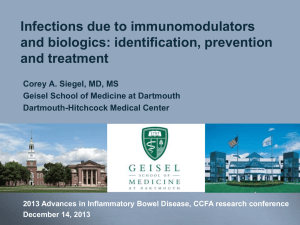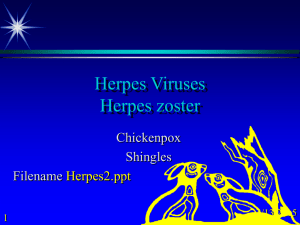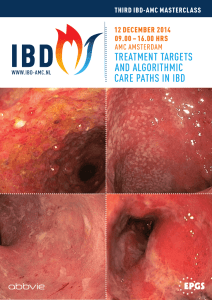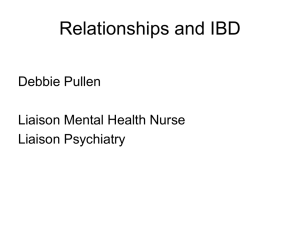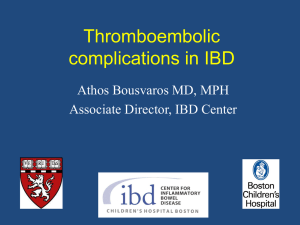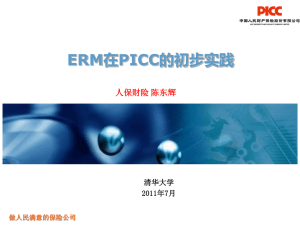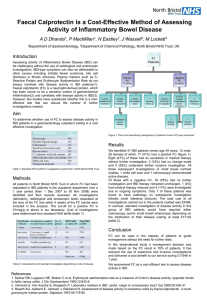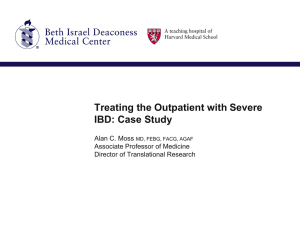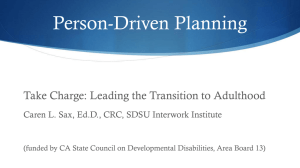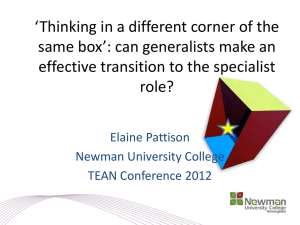MMWR - Advances in Inflammatory Bowel Diseases
advertisement
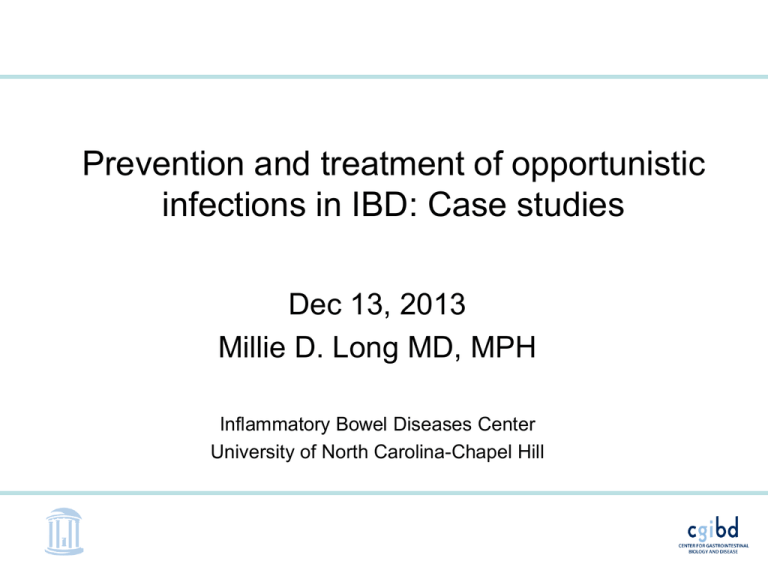
Prevention and treatment of opportunistic infections in IBD: Case studies Dec 13, 2013 Millie D. Long MD, MPH Inflammatory Bowel Diseases Center University of North Carolina-Chapel Hill Case 1 • 29 year old female with colonic CD • Hypersensitivity rxn to thiopurines • Maintained on infliximab monotherapy 10 mg/kg q 8 weeks • Previously on MTX, this was d/c due to desire for pregnancy • Clinically in remission • Calls with new onset painful rash on her back Skin Herpes Zoster • Herpes zoster (HZ) is caused by reactivation of latent varicella zoster virus (VZV) • 1 million cases annually • In the US, lifetime risk approaching 1 in 3 • About 10%–18% of persons with HZ develop post-herpetic neuralgia (PHN) Leung J, et al. Clin Infect Dis. 2011 Feb;52(3):332-40. Herpes Zoster in IBD • Incidence of zoster is higher in IBD – 20 - 50% increase in UC – 60 - 90% increase in CD • Incidence increases with age • Medications associated with zoster – – – – Corticosteroids (adjusted OR 1.5 – 1.7) Azathioprine/6-mp (adjusted OR 1.9 - 3.1) Biologic anti-TNF (adjusted OR 1.8) Combo therapy (adjusted OR 3.3) Gupta et al. Clin Gastroenterol Hepatol. 2006 Dec;4(12):1483-90. Long MD et al. Aliment Pharmacol Ther. 2013; 37: 420-9. Herpes Zoster in IBD Long MD et al. Aliment Pharmacol Ther. 2013; 37: 420-9. Herpes Zoster in IBD Long MD et al. Aliment Pharmacol Ther. 2013; 37: 420-9. HZ and Anti-TNF • New users of anti-TNF identified (all indications, IBD, RA, psoriatic arthritis, etc) • Compared incidence of HZ after initiation of antiTNF versus standard DMARD (mtx, etc for RA) • Among anti-TNF users for IBD, incidence 11.3/1000 patient-years • Adjusted HR for anti-TNF: HR 1.09 (0.88-1.36) as compared to other DMARDs (aza/6mp) • 2-fold increased risk with corticosteroids in IBD (adjusted HR 1.99; 95% CI, 1.12-3.52) Winthrop KL, et al. JAMA. 2013: 309 (9): 887-95. Prevention? Zoster Vaccination • Administered as a single 0.65 mL dose • No need to ask about history of varicella (chickenpox) or to have serologic testing as indicated only in individuals >60 • Zoster vaccination is not recommended for persons of any age who have received varicella vaccine • Live vaccine – Inactivated vaccine is in development MMWR, June 6, 2008, Vol 57, #5 Prevention of Herpes Zoster ACIP Recommendations • Zoster vaccine is recommended for all persons aged >60 years who have no contraindications, including persons who report a previous episode of zoster or who have chronic medical conditions • Zoster vaccination is not indicated to treat acute zoster, or to prevent persons with acute zoster from developing PHN MMWR, June 6, 2008, Vol 57, #5 Prevention of Herpes Zoster ACIP Recommendations • Those >60 with anticipated immunosuppression should be vaccinated • Zoster vaccine should be administered at least 14 days before initiation of immunosuppressive therapy, although some recommend waiting 1 month after zoster vaccination to begin immunosuppressive therapy if delay is possible MMWR, June 6, 2008, Vol 57, #5 Prevention of Herpes Zoster ACIP Contraindications • Zoster vaccine should not be administered to persons with primary or acquired immunodeficiency including: – Persons on immunosuppressive therapy, including high-dose corticosteroids (>20 mg/day of prednisone or equivalent) lasting two or more weeks. – Zoster vaccination should be deferred for at least 1 month after discontinuation of such therapy MMWR, June 6, 2008, Vol 57, #5 Prevention of Herpes Zoster ACIP Allowed Immunosuppression • Short-term corticosteroid therapy (<14 days); low-tomoderate dose (<20 mg/day of prednisone or equivalent) • Therapy with low-doses of methotrexate (<0.4 mg/Kg/week), azathioprine (<3.0 mg/Kg/day), or 6mercaptopurine (<1.5 mg/Kg/day) for treatment of autoimmune conditions are also not considered sufficiently immunosuppressive to create vaccine safety concerns and are not contraindications • Contraindication with anti-TNF medications MMWR, June 6, 2008, Vol 57, #5 Prevention of Herpes Zoster Vaccination and anti-TNF use • Retrospective cohort, Medicare claims, age 60+ with immune-mediated dz (RA, IBD, etc), 2 yrs • 4.0% of patients received HZ vaccine – Overall incidence of zoster 7.8 cases per 1000 person-years (95% CI, 3.7-16.5) – Rate among the unvaccinated was 11.6 cases per 1000 person-years (95% CI, 11.4-11.9) • 633 patients on biologics – no HZ cases • HZ vaccination HR 0.61 (95% CI, 0.52-0.71) for HZ risk after 42 days Zhang J, et al. JAMA. 2012 Jul 4;308(1):43-9. Clinical Questions • • • • • How do you treat her? Do you alter her infliximab? Do you consider prophylaxis? Do you vaccinate? Have you seen zoster in your practice? – What risk factors have you noted? • How do you use HZ vaccination in your practice? Back to the case • Treatment with valacyclovir, gabapentin for pain • Infliximab held acutely until blisters scabbed over • Infliximab restarted at prior dose • No treatment with acyclovir or valacyclovir prophylaxis for now, will follow her clinically to see if evidence of recurrence Case 2 Case 2 • 44 year old AA female with long-standing history of colonic CD with peri-anal pyoderma that has been medically refractory, has diverting colostomy • Prior failed treatment regimens have included: – – – – – Anti-TNF medications MTX, Aza/6mp (including combination therapy) Corticosteroids Cyclosporine Natalizumab Case 2 • Currently maintained on anti-TNF and q2 weekly intralesional kenalog injections into pyoderma • Calls with increasing fatigue and SOB, in clinic O2 sat is 90% on room air, lungs with decreased breath sounds bilaterally at bases Case 2 : CXR Opacification at bases bilaterally Bronch/BAL confirms diagnosis PCP (PJP) • Case reports have described cases of Pneumocystis jiroveci pneumonia (formerly known as Pneumocystis carinii or PCP) in IBD associated with immunosuppression – – – – – Azathioprine Corticosteroids Cyclosporine Anti-TNF Combinations Khatchatourian M, Seaton TL. Am J Gastroenterol. 1997;92:1558–1560. Takenaka R, et al. J Gastroenterol. 2004;39:1114–1115. PCP (PJP) • PCP is an atypical unicellular fungus that produces alveolar infiltrates and local inflammatory reactions, which widen the alveolar–arterial oxygen gradient. • PCP is associated with high rates of morbidity and mortality given its profound effects on gas exchange Poppers DM, Scherl EJ. Inflamm Bowel Dis. 2008;14:106–113. Jones JL, et al. MMWR CDC Surveill Summ. 1999;48: 1–22. Incidence of PCP in IBD and non-IBD Populations Annual PCP Incidence per 100,000 20 15 13 11 10 5 8 3 3 3 CD UC IBD 0 Long MD, et al. Inflamm Bowel Dis. 2013 Apr;19(5):1018-24 Non-IBD CD or UC Medications and PCP in IBD • 20 (53%) were on steroids alone or in combination with other medications • A total of 19 individuals (50%) had a hospitalization in the 60 days before PCP diagnosis • More comorbidities Adalimumab/infliximab PCP and Prophylaxis: ECCO consensus * All were infectious disease specialists PCP and prophylaxis: considerations • Patients on high-dose corticosteroids • Patients on triple immunosuppression with corticosteroids, anti-metabolites, and anti-TNF or calcineurin inhibitor • Lymphopenia (absolute lymphocyte count <600, CD4+ lymphocyte count less than 300) • Patients w/ multiple comorbidities (COPD) • Patients older than 55 years • Prophylaxis rates on combination therapy are low: 11% from one provider survey Okafor PN, et al. Inflamm Bowel Dis. 2013 Jul;19(8):1764-71. Okafor PN, et al. Inflamm Bowel Dis. 2013;19:812–817 Clinical Questions • Who has had a case of PJP (PCP)? Has this case impacted your prescribing patterns of prophylaxis? • For whom do you offer prophylaxis in your practice? • What do you commonly use for prophylaxis? • What downsides do you see to prophylaxis? Back to the case… • • • • Hospitalized in ICU Required intubation, bronch/BAL Treated with SMP/TMX and corticosteroids Eventually with improved oxygenation and full recovery after prolonged hospital course • Pyoderma unchanged Case 3 Case 3 • 31 year old male with ileocolonic CD failed multiple therapies including mesalamine, antibiotics, budesonide, immunomodulators and several anti-TNF-a medications. • May 2008, started on natalizumab (NZB) with a rapid and sustained response. A baseline MRI was normal. • In March 2011, 35th infusion of NZB. • Two weeks later (day 0), difficulty with concentration and visual field defects Case • On day 6, a brain MRI demonstrated increased T2 and FLAIR signal in the left parieto-occiptal lobe PML • Within 24 hours, he underwent a lumbar puncture. CSF PCR for JC virus had 2.9 million copies, confirming PML. Plasma exchange (PLEX) was initiated to remove circulating NZB. • Mirtazapine 15mg daily was started on day 8 due to in vitro evidence for inhibition of JC virus. • He underwent five PLEX sessions (1.5 plasma volumes, albumin replacement) over ten days. PML • On Day 17, worsening expressive aphasia and visual symptoms. • Methylprednisolone 1 gram/day followed by a prednisone taper was started for suspected immune reconstitution inflammatory syndrome (IRIS). • By Day 49, he had receptive aphasia and rightsided sensory and motor loss. Brain MRI showed progression of PML lesions • PML • Mirtazapine was increased to 60mg daily, and mefloquine 250mg daily for three days, followed by 250mg weekly for three weeks, was started due to in vitro activity against JC virus. • By Day 76, he reached a nadir of neurologic function, with receptive aphasia, one word sentences and minimal right-sided motor or sensory function. Slow recovery followed. • By Day 113, he tapered off corticosteroids. Most recent brain MRI showed left cerebral involution. MRI Series A B C A: Initial PML diagnosis (day 6). B: Extention of PML (day 53). C: Last follow-up MRI with cerebral involution (day 167). PML • Progressive multifocal leukoencephalopathy (PML) is a rare neurologic disorder caused by a common human virus (JC virus) that infects oligodendrocytes, resulting in demyelination or destruction of the cells in the brain and usually death within months • PML is typically seen in immunosuppressed patients with cancer, those who have undergone organ transplant, or AIDS patients with depressed T cell function Keeley KA, et al. Ann Pharmacother. 2005 Nov;39(11):1833-43. PML and Natalizumab • As of 2012, 212 confirmed cases of PML among 99,571 MS patients on natalizumab (2.1 /1000) • All 54 patients with PML for whom samples were available were positive for anti-JC virus Ab • Risk among those JC virus negative: 0.09 cases or less/1000 patients (95% CI 0 to 0.48) • Factors associated with increased risk: – JC virus positive – Prior immunosuppression – 25-48 months of therapy (longer duration) Bloomgren G, et al. N Engl J Med. 2012 May 17;366(20):1870-80 PML Prevention? • The risk of PML should be stratified into high, medium and low risk groups according to presence or absence of anti-JC virus antibodies, prior immunosuppressive therapy, and treatment duration. • Anti JC virus (Anti-JCV) Ab testing is now widely available • Anti-JCV Ab prevalence in a large, diverse, multi-national multiple sclerosis (MS) cohort was 57.6%. Olsson T, et al. Mult Scler. 2013 Oct;19(11):1533-8 Clinical Questions • Do you use natalizumab in your practice? – TOUCH program • Do you test for anti-JCV Ab? • Do you have a protocol for testing once on therapy? – Note: false-negative rate of 2.7% (95% CI, 0.9–6.2). • Do you pull patients off of natalizumab who turn anti-JCV Ab positive? Bozic C, et al. Ann Neurol. 2011 Nov;70(5):742-50. Back to the case… • At last follow-up, he has persistent expressive aphasia limiting the fluency of speech but he is able to follow commands • He has 4/5 strength and mildly decreased sensation to light touch on the right side • He is disabled
